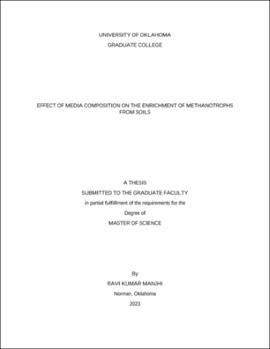| dc.contributor.advisor | Qin, Wei | |
| dc.contributor.author | Manjhi, Ravi | |
| dc.date.accessioned | 2023-07-18T20:02:15Z | |
| dc.date.available | 2023-07-18T20:02:15Z | |
| dc.date.issued | 2023-08-04 | |
| dc.identifier.uri | https://hdl.handle.net/11244/337934 | |
| dc.description.abstract | Methanotrophic bacteria play a crucial role in regulating methane (an important greenhouse gas) release into the environment by oxidizing it. In the last 50 years, several new genera and species of methanotrophs have been documented, and many methanotrophs have been cultivated. However, several lineages of methanotrophs lack cultivated representatives and this creates a challenge in studying their metabolism, physiology, and biochemistry. To cultivate more diverse groups of methanotrophs, we wanted to determine the effect of using 11 different NMS based media types on the growth of methanotrophic enrichment cultures. Soil samples were inoculated from Norman landfill and duckpond. Methane oxidation was monitored, and cells were harvested from the highest two dilutions, which exhibited methane oxidation. 16S rRNA and pmoA gene amplicon analysis was done from the DNA of the harvested cells. AMS had an inhibitory effect on the initial methane oxidation rate of methanotrophs in the enrichment cultures. We found there was a relatively higher abundance of methanotrophs in landfill (12%) soil sample compared to the duckpond (< 3%). The most abundant cultivable methanotrophic OTU in enrichment cultures was Methylocystis in landfill cultures and Methylomonas in duckpond cultures. These methanotrophs were present in all the enrichment media cultures. The methanotrophic OTUs found in the enrichment cultures were from genera Methylocystis, Methylomonas, Methylomicrobium and Methylobacter. Methanotrophic sequences from Methylococcus and Methyloparacoccus were present in the soil samples but not detected in any of our enrichment cultures. Methylotrophic sequences were present (10%) in our duckpond methanotrophic enrichment cultures, but not in the landfill cultures. The co-existence of methanotrophs and methylotrophs is likely due to nutrient sharing. The media type with largest number of methanotrophic OTUs were NMS and NMS (1:5) at pH 7. NaHCO3 and 1% O2 (11/12 OTUs) were effective in duckpond enrichments whereas NMS (1:5) pH 6 (5/5 OTUs) were effective in landfill enrichments. There was a pH effect on the methanotrophic OTUs where more OTUs (11/12) were present at pH 7 compared to pH 6 and 8 (6/12) in duckpond cultures. An effect of catalase (50 µg/ml) was observed in duckpond cultures which led to lowest number of methanotrophic OTU (only Methylomonas) present in duckpond cultures. Our results from this study suggest that medium type affects the methane oxidation activity of methanotrophs and their relative abundance in enrichment cultures. | en_US |
| dc.language | en_US | en_US |
| dc.subject | Methanotroph | en_US |
| dc.subject | Enrichment media | en_US |
| dc.subject | Community composition | en_US |
| dc.subject | Cultivation of methanotrophs | en_US |
| dc.title | Effect of Media Composition on the Enrichment of Methanotrophs from Soils | en_US |
| dc.contributor.committeeMember | Krumholz, Lee | |
| dc.contributor.committeeMember | Sankaranarayanan, Krithivasan | |
| dc.date.manuscript | 2023-07 | |
| dc.thesis.degree | Master of Science | en_US |
| ou.group | Dodge Family College of Arts and Sciences::Department of Microbiology and Plant Biology | en_US |
| shareok.nativefileaccess | restricted | en_US |
